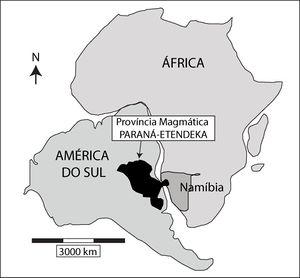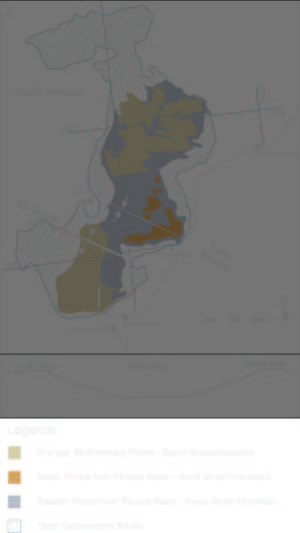Parana-Etendeka CBP
| Wiki Write-Off Entry | |
|---|---|

| |
| Student Chapter | Federal University of Rio Grande do Sul |
| Competition | June 2015 |
Parana-Etendeka Continental Basaltic Province represents one of the major volcanic events on Earth’s history. It's characterized by a fissural volcanism that occurred in the Early Cretaceous before the Gondwana rift and opening of South Atlantic Ocean. About 90% of the volcanism is found in South America, covering 1,200,000 km² over the Parana Basin (Parana Continental Basaltic Province). The other 10% are in Etendeka (Etendeka Continental Basaltic Province), and Angola, Africa (Figure 1).

The Parana Continental Basaltic Province covers an area of 917,000 km² and has a volume of 450,000 km³.[2] It is composed mostly (90% of volume) by basaltic and andesitic basalts rocks with a tholeiitic affinity. Acidic rocks occur locally in the upper volcanic pile. Chemically the basalts were divided in two groups based in the TiO2 contents: The first group occurs dominantly in southern areas and has TiO2 lower than 2 wt.%, the second group has high TiO2 (>2%) and is dominant in the northern portion of the Parana Basin.[3][4] These two groups of basaltic rocks were sub-divided in six magma types:[5] Gramado, Esmeralda and Urubici (Ti/Y<300) in the south, and Pitanga, Paranapanema and Ribeira (Ti/Y>300) in the northern magmas.

Acidic rocks are characterized by high crystallization temperatures. In the Paraná Basin, temperatures obtained by the coexisting pyroxenes method are 1,030 ± 38ºC:[3]. Chemically the acidic rocks are also divided in two groups[3][7]
- Palmas type, dacitic and rhyolitic rocks with low TiO2 and low contents of incompatible elements, dominant in the south of Parana Basin and is sub-divided in 5 sub-groups based on chemical characteristics:[5][8] Caxias do Sul, Santa Maria, Anita Garibaldi, Clevelandia and Jacui.
- Chapeco Type, porphyritic trachytes with high-TiO2, Ba, P, Zr and Sr. Present in the north and middle portions of the basin and is sub-divided in 3 sub-groups: Ourinhos, Guarapuava[7] and Tamanara.[8]
The age of magmatism in the Serra Geral Formation is Early Cretaceous. The volcanic rocks are slightly older in the south portion ranging from 131,4 ± 1,6 to 132,9 Ma, becoming younger in middle (129,9 ± 0,1 Ma ) and north (131,9 ± 0,9 Ma ).[9] The duration of the main phase of the volcanism was <1.2 My[9] (Continental Basaltic Provinces are known to display a variety of lava flow morphologies).
Furthermore, studies based in the morphology of different magma types and the facies architecture[10][11][6] has helped the understanding the paleotopography, emplacement and volumetric flow rate of Parana Etendeka volcanism.
References
- ↑ Jerram, D. A., 2002, Volcanology and facies architecture of flood basalts, in M. A. Menzies, S. L. Klemperer, C. J. Ebinger, and J. Baker, eds., Magmatic rifted margins: Geological Society of America Special Paper 362, pp. 119–132.
- ↑ Frank, H. T., M. E. B. Gomes, and M. L. L. Formoso, 2009, Review of the areal extent and the volume of the Serra Geral Formation, Parana Basin, South America: Pesquisa em Geociências, v. 36, p. 49–57.
- ↑ 3.0 3.1 3.2 Bellieni, G., P. Comin-Chiaramonti, L. S. Marques, A. J. Melfi, E. M. Picirillo, A. J. R. Nardy, and A. Roisenberg,1984, High- and Low Ti flood basalts from the Paran_a plateau (Brazil): petrogenetic and geochemical aspects bearing on their mantle origin: Neues Jahrb. für Mineral. Abh, v. 150, p. 272–306.
- ↑ Mantovani, M. S. M., L. S. Marques, M. A. De Sousa, L. Civetta, L. Atalla, and F. Innocenti, 1985, Trace element and strontium isotope constraints on the origin and evolution of Parana continental flood basalts of Santa Catarina State, southern Brazil: J. Petrol., v. 26, p. 187–209.
- ↑ 5.0 5.1 Peate, D. W., C. J. Hawkeswort, and M. S. M. Mantovani, 1992, Chemical stratigraphy of the Parana lavas (South America): classification of magma types and their spatial distribution: Bull. Volcanol, v. 55, p. 119–139.
- ↑ 6.0 6.1 Rossetti, L. M., E. F. Lima, B. L. Waichel, C. M. Scherer, and C. J. Barreto, 2014, Stratigraphical framework of basaltic lavas in Torres Syncline Main Valley, Southern Brazil: Journal of South American Earth Sciences, v. 56, p. 409–421
- ↑ 7.0 7.1 Peate, D. W., 1997, The Parana-Etendeka province, in J. J. Mahoney, and M. Coffin, eds., Large Igneous Provinces: Continental, Oceanic, and Planetary Volcanism: American Geophysical Union Geophysical Monograph 100, p. 217–245.
- ↑ 8.0 8.1 Nardy, A. J. R., F. B. Machado, and M. A .F. Oliveira, 2008, As rochas vulcânicas mesozoicas ácidas da Bacia do Paraná: litoestratigrafia e considerações geoquímicas-estratigráficas: Revista Brasileira de Geociências, v. 38, no. 1, p. 178–195.
- ↑ 9.0 9.1 Renne, P. R., M. Ernesto, I. G. Pacca, R. S. Coe, J. M. Glen, M. Prevot, and M. Perrin, 1992, The age of the Paraná Flood Volcanism, rifting of Gondwanaland, and the Jurassic-Cretaceous boundary: Science, v. 258, p. 975–979
- ↑ Lima, E. F., B. L .Waichel, L. M. M. Rossetti, A. R. Viana, C. M. Scherer, G. V. Bueno, and G. Dutra, 2012, Morphological and petrographic patterns of the pahoehoe and aa flows of the Serra Geral Formation in the Torres Syncline: Revista Brasileira de Geociências, v. 42, no. 4, p. 744–753.
- ↑ Waichel, B.L., E. F. Lima, A. R. Viana, C. M. Scherer, G. V. Bueno, and G. Dutra, 2012, Stratigraphy and volcanic facies architecture of the Torres Syncline, Southern Brazil, and its role in understanding the Paran_a-Etendeka Continental Flood Basalt Province: J. Volcanol. Geotherm. Res., v. 216, p. 74–82.